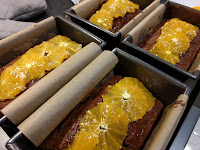It's Pancake Day!
It's the one day of the year when I make pancakes. I normally do the traditional "crepe"-style pancakes, however to be honest I don't really like them. This year I dug out a recipe for some scotch pancakes instead...something I really like, but have never made (I affectionately knew them as pixie-pillows). These were remarkably easy to make, though not quite as orang'y as I hoped. The recipe made about 12 of what I would consider a decent pancake (the recipe claimed 24...they would be very small). I found you could do them in batches of 3 in a normal frying pan.
 1) Put the flour, sugar, baking powder and caster sugar in a bowl, and mix with a whisk
1) Put the flour, sugar, baking powder and caster sugar in a bowl, and mix with a whisk
2) Zest the oranges into a bowl
 3) Juice the oranges into a jug (I got approx 100ml of orange juice out of them)
3) Juice the oranges into a jug (I got approx 100ml of orange juice out of them)
4) Top the juice up to 200ml with milk
5) Put the egg and half the orange juice mixture into the flour, and mix until smooth
 6) Slowly add the rest of the orange juice mixture until you have a thick, creamy batter
6) Slowly add the rest of the orange juice mixture until you have a thick, creamy batter
7) Pour a small amount of sunflower oil into a large frying pan, over a medium heat
8) Pour 2 tbsp of the batter into the frying pan (you should be able to fit 3 pancakes of this size into the pan)
 9) Fry until bubbles appear and form on the upper side, then flip carefully (it will be quite quick...1-2 minutes per pancake)
9) Fry until bubbles appear and form on the upper side, then flip carefully (it will be quite quick...1-2 minutes per pancake)
 10) Fry the other side for approximately 1 minute, then remove to a plate (you should be able to do 4 batches of 3)
10) Fry the other side for approximately 1 minute, then remove to a plate (you should be able to do 4 batches of 3)
11) Serve with golden syrup
It's the one day of the year when I make pancakes. I normally do the traditional "crepe"-style pancakes, however to be honest I don't really like them. This year I dug out a recipe for some scotch pancakes instead...something I really like, but have never made (I affectionately knew them as pixie-pillows). These were remarkably easy to make, though not quite as orang'y as I hoped. The recipe made about 12 of what I would consider a decent pancake (the recipe claimed 24...they would be very small). I found you could do them in batches of 3 in a normal frying pan.
Orange Scotch Pancakes - Recipe
Ingredients
- 2 Oranges
- Approximate 100ml milk
- 175 self-raising flour
- 1tsp baking powder
- 40g caster sugar
- 1 egg
- Sunflower oil
- Golden syrup (to serve)
 1) Put the flour, sugar, baking powder and caster sugar in a bowl, and mix with a whisk
1) Put the flour, sugar, baking powder and caster sugar in a bowl, and mix with a whisk2) Zest the oranges into a bowl
 3) Juice the oranges into a jug (I got approx 100ml of orange juice out of them)
3) Juice the oranges into a jug (I got approx 100ml of orange juice out of them)4) Top the juice up to 200ml with milk
5) Put the egg and half the orange juice mixture into the flour, and mix until smooth
 6) Slowly add the rest of the orange juice mixture until you have a thick, creamy batter
6) Slowly add the rest of the orange juice mixture until you have a thick, creamy batter7) Pour a small amount of sunflower oil into a large frying pan, over a medium heat
8) Pour 2 tbsp of the batter into the frying pan (you should be able to fit 3 pancakes of this size into the pan)
 9) Fry until bubbles appear and form on the upper side, then flip carefully (it will be quite quick...1-2 minutes per pancake)
9) Fry until bubbles appear and form on the upper side, then flip carefully (it will be quite quick...1-2 minutes per pancake) 10) Fry the other side for approximately 1 minute, then remove to a plate (you should be able to do 4 batches of 3)
10) Fry the other side for approximately 1 minute, then remove to a plate (you should be able to do 4 batches of 3)11) Serve with golden syrup














































